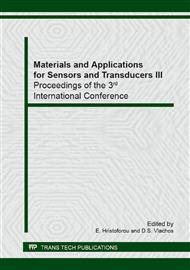p.577
p.581
p.585
p.589
p.593
p.597
p.601
p.605
p.609
Morphology and Laser-Induced Photochemistry of Silicon and Nickel Nanoparticles
Abstract:
The structural and photoinduced properties of silicon nanoparticles obtained by plasmachemical and electrolytic techniques and the nickel particles deposited on aluminum oxide film in ultra-high vacuum are investigated by Auger electron spectroscopy, transmission electron microscopy, Fourier-transform infrared spectroscopy and time-of-flight spectroscopy. It is found that substantial increase of silicon nanoparticle photoinduced luminescence can be attributed to particle specific structure, as well as to the SiO2 thin film which is formed on the nanocrystalline silicon surface. In case of Ni particles deposited on aluminum oxide film at low mean coverage of about 0.04 monolayers, when the film can be viewed as consisting of separated single adsorbed atoms or very small clusters, the photon irradiation by nanosecond pulsed laser leads to NO desorption. At monolayer Ni coverage formed at a substrate temperature of 80 K laser irradiation causes dissociation of NO molecules. Efficiency of this process at the initial stage is notably enhanced compared to that of NO on the bulk Ni (111) crystal. This enhancement can be attributed to the effect of underlying aluminum oxide support.
Info:
Periodical:
Pages:
593-596
Citation:
Online since:
April 2014
Price:
Сopyright:
© 2014 Trans Tech Publications Ltd. All Rights Reserved
Share:
Citation:


